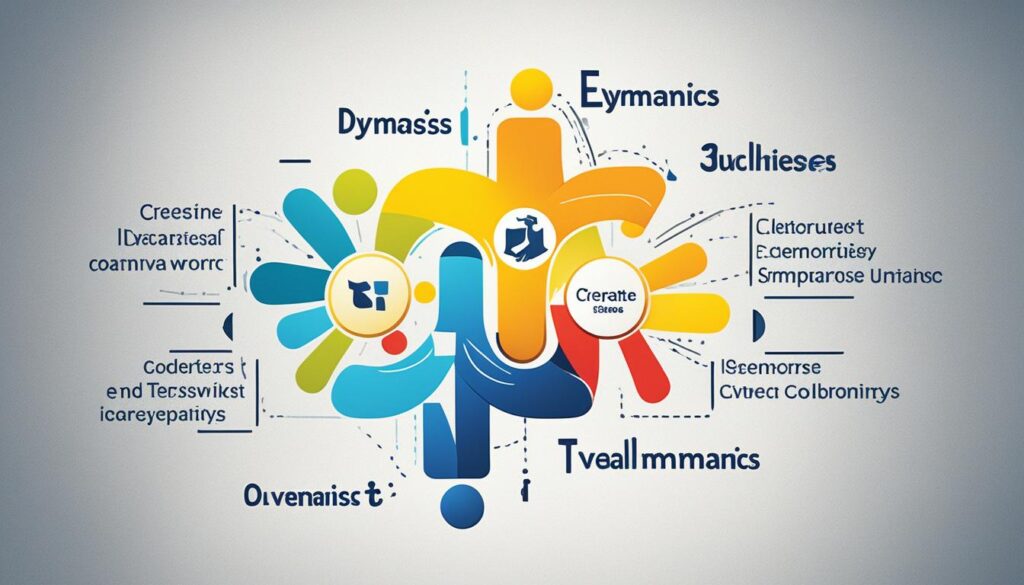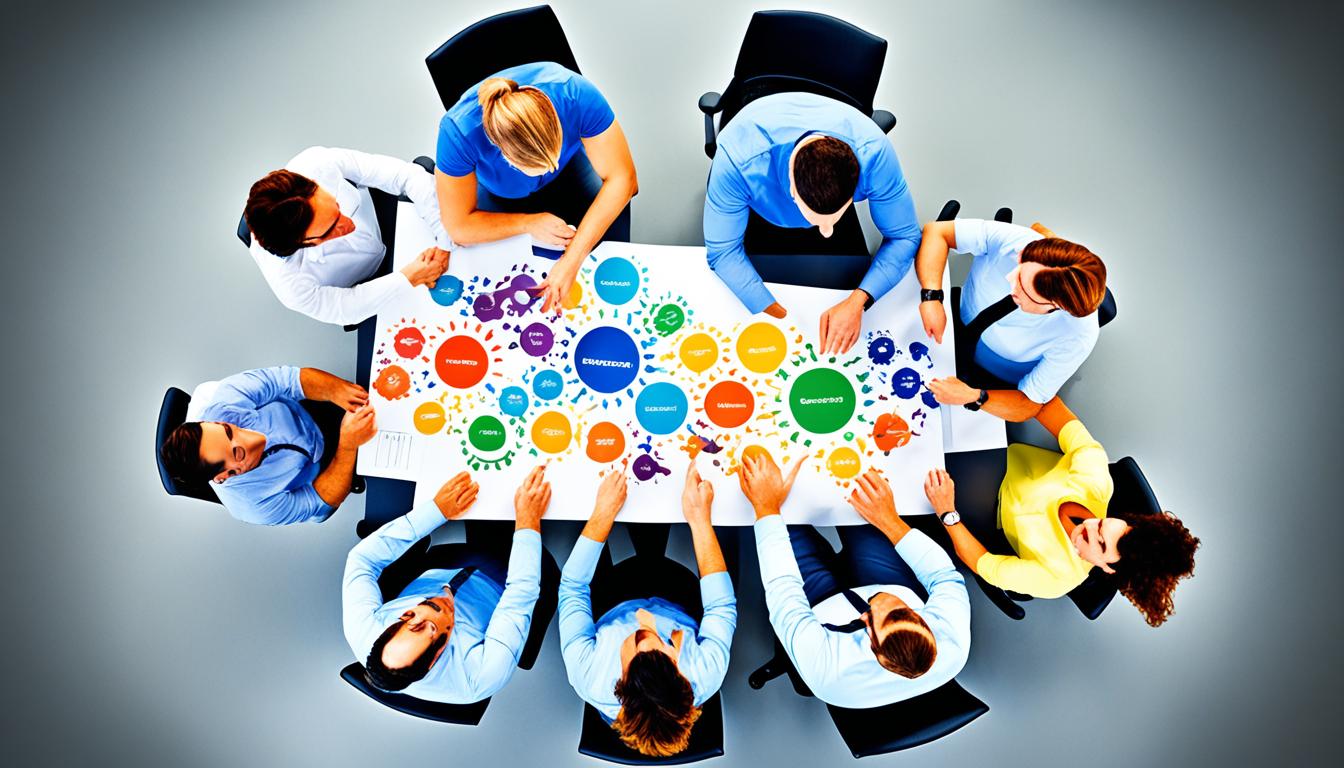Introduction
Team dynamics – it’s a term we often hear in the workplace, but what does it really mean? Let me share a story that sheds light on the importance of team dynamics.
A few years ago, I joined a marketing team at a thriving tech startup. We were a diverse group of individuals with unique skills and backgrounds. Our team leader, Sarah, believed in the power of collaboration and nurturing positive team dynamics. She understood that when we work together harmoniously, we can achieve remarkable results.
One day, we were faced with a challenging project. We needed to launch a new product within a tight deadline. The pressure was on, and tensions were high. Sarah gathered our team in a meeting room and encouraged us to openly share our ideas and concerns. She wanted to create an environment where everyone felt heard and valued.
As we began brainstorming, something magical happened. Our individual strengths and perspectives came together like pieces of a puzzle. Ideas flowed freely, collaboration was seamless, and the energy in the room was electrifying. We were each contributing our best, building on one another’s ideas, and finding innovative solutions.
With clear roles and responsibilities, effective communication, and a strong sense of camaraderie, we managed to not only meet the project deadline but exceeded expectations. Not only did we launch the new product successfully, but our team’s performance and morale reached new heights.
Through this experience, I realized the true meaning and importance of team dynamics in the workplace. It’s about creating an environment where each team member feels empowered, respected, and valued. It’s about leveraging our individual strengths and collaborating towards a common goal. It’s about fostering open communication, trust, and a sense of belonging.
Key Takeaways:
- Team dynamics refer to the patterns of communication, cooperation, and collaboration within a team.
- Effective team dynamics impact innovation, productivity, employee satisfaction, and overall success.
- Poor team dynamics can significantly affect team performance.
- Positive team dynamics enhance collaboration, improve communication, boost morale and motivation, enable effective conflict resolution, promote accountability, foster professional development, enhance cultural understanding, increase resilience to change, contribute to a high-performance culture, and attract and retain talent.
- By nurturing positive team dynamics, organizations can unlock the full potential of their teams, create a harmonious work environment, foster innovation, and drive sustainable growth.
What is Team Dynamics at Work?
Team dynamics at work encompass the interactions, relationships, and behaviors among individuals within a team. It includes both formal aspects such as roles and structure, and informal aspects such as interpersonal relationships and communication styles. Team dynamics involve various elements such as communication patterns, power structures, conflict resolution strategies, and the level of trust within the team. It extends beyond formal meetings and projects to informal interactions and digital communication channels. Understanding and managing these dynamics are essential for creating a cohesive and high-performing team.
| Elements of Team Dynamics at Work | Descriptions |
|---|---|
| Communication patterns | The ways in which team members exchange information, ideas, and feedback. |
| Power structures | The distribution of authority, decision-making, and influence within the team. |
| Conflict resolution strategies | The approaches used to address and resolve disagreements and conflicts within the team. |
| Level of trust | The degree to which team members trust and rely on each other. |
Team dynamics at work are complex and constantly evolving. They can greatly impact team communication, collaboration, and overall performance. By understanding the dynamics at play, team leaders can create an environment that fosters open communication, encourages collaboration, and promotes positive group dynamics. Effective team dynamics contribute to a cohesive and engaged team that can effectively tackle challenges, innovate, and achieve shared goals.
Importance of Team Communication
Effective team communication is a crucial component of team dynamics at work. It enables the sharing of information, ideas, and feedback, ensuring that everyone is on the same page and working towards a common goal. Strong communication within a team enhances collaboration, promotes transparency, minimizes misunderstandings, and resolves conflicts. It fosters trust, boosts morale, and empowers team members to contribute their unique perspectives and expertise. Open and effective communication channels are key to creating a positive and productive team environment.
The Importance of Team Dynamics in the Workplace
Team dynamics play a vital role in shaping the success and productivity of a workplace. Positive team dynamics enhance collaboration, improve communication, boost morale and motivation, enable effective conflict resolution, promote accountability, foster professional development, enhance cultural understanding, increase resilience to change, contribute to a high-performance culture, and attract and retain talent.
By nurturing positive team dynamics, organizations can unlock the full potential of their teams, create a harmonious work environment, foster innovation, and drive sustainable growth.
Collaboration and Communication
Effective team dynamics encourage collaboration and communication among team members. By working together towards a common goal, team members can leverage their expertise, share ideas, and find innovative solutions to complex problems. Open and transparent communication ensures that everyone is aligned and informed, enhancing overall productivity and efficiency within the team.
Morale and Motivation
Positive team dynamics contribute to high morale and motivation within the team. When team members feel valued, respected, and included, they are more likely to be engaged and committed to their work. Recognition, appreciation, and opportunities for growth and development further enhance motivation, leading to higher levels of job satisfaction and performance.
Effective Conflict Resolution and Accountability
Strong team dynamics facilitate effective conflict resolution and establish a culture of accountability. By promoting open dialogue and mutual understanding, team members can address conflicts constructively, find common ground, and reach mutually beneficial outcomes. In addition, team dynamics ensure that everyone takes responsibility for their actions, promoting a sense of ownership and fostering a culture of accountability.
Professional Development and Cultural Understanding
Nurturing positive team dynamics provides opportunities for professional development and enhances cultural understanding. Team members can learn from each other’s experiences, skills, and perspectives, fostering a continuous learning environment. By embracing diversity and promoting inclusivity, team dynamics create a platform for cultural exchange, enabling individuals to broaden their horizons and develop a deeper appreciation for different backgrounds and perspectives.
Resilience to Change and High-Performance Culture
Teams with strong dynamics are more resilient to change and can adapt quickly to new challenges and opportunities. By fostering a culture of continuous improvement and learning, team dynamics encourage agility and innovation, enabling teams to thrive in dynamic and competitive environments. This commitment to excellence contributes to a high-performance culture, where teams consistently deliver superior results and exceed expectations.
Attract and Retain Talent
Positive team dynamics are attractive to both existing and potential talent. Organizations that prioritize collaboration, open communication, and mutual respect create an environment that appeals to highly skilled professionals. By fostering positive team dynamics, organizations can not only attract top talent but also retain their best employees, reducing turnover rates and building a stable and high-performing workforce.
| Benefits of Positive Team Dynamics in the Workplace |
|---|
| Enhanced collaboration and communication |
| Boosted morale and motivation |
| Effective conflict resolution and accountability |
| Opportunities for professional development and cultural understanding |
| Resilience to change and a high-performance culture |
| Ability to attract and retain talent |
Examples of Team Dynamics
Successful team dynamics are exemplified through various examples that showcase the potential for team synergy, performance, and leadership. These real-world scenarios highlight the impact of individual behavior on team cohesiveness and productivity:
The Collaborative Orchestra
The collaborative orchestra represents a team where members with diverse skills collaborate seamlessly, much like an orchestra, to solve complex problems. Each team member brings their unique expertise and background to the table, playing their respective roles to create a harmonious and successful outcome. This example emphasizes the importance of effective communication and cooperation, as well as the ability to appreciate and leverage individual strengths to achieve a collective goal.
The Constructive Challenger
The constructive challenger is a team member who encourages critical thinking and alternative solutions within the team. They promote intellectual curiosity and challenge the status quo, contributing to the overall growth and innovation of the team. By fostering an environment that values constructive feedback and diverse perspectives, the constructive challenger stimulates creative problem-solving and enables team members to reach their full potential.
The Synergy Spark
The synergy spark describes a team where camaraderie and positive relationships inspire creativity and productivity. By nurturing a supportive and collaborative atmosphere, team members feel empowered to share ideas, take risks, and work together seamlessly. This example highlights the importance of social dynamics and the impact of a cohesive team culture on individual performance and overall team success.
The Mentorship Nexus
In the mentorship nexus, seasoned team members take on the role of mentors, guiding and supporting junior colleagues. Through mentorship, knowledge transfer occurs, fostering continuous growth and development within the team. The mentorship nexus underscores the significance of team leadership, mentorship, and the cultivation of a learning environment that values professional growth and the exchange of expertise.
The Inclusion Initiator
The inclusion initiator plays a vital role in ensuring that every team member’s voice is heard and valued, particularly within diverse teams. By championing inclusivity, this team member fosters psychological safety and encourages a sense of belonging for all team members. The inclusion initiator enriches team dynamics by promoting diversity, equity, and inclusion, ultimately enhancing team performance, innovation, and overall success.
These examples highlight the significance of individual behavior and the influence it has on team dynamics, team synergy, team performance, and team leadership.

| Example | Key Focus | Main Takeaway |
|---|---|---|
| The Collaborative Orchestra | Effective collaboration and leveraging of diverse skills | Communication and cooperation are crucial for team success |
| The Constructive Challenger | Promoting critical thinking and alternative solutions | Embrace diverse perspectives and encourage intellectual curiosity |
| The Synergy Spark | Inspiring creativity and productivity through camaraderie | A supportive team culture enhances individual and team performance |
| The Mentorship Nexus | Mentoring and guiding junior colleagues | Leadership and knowledge transfer fuel continuous growth |
| The Inclusion Initiator | Promoting inclusivity and valuing diverse perspectives | Diversity and inclusion drive team performance and innovation |
The Three Categories in Team Dynamics
Team dynamics play a crucial role in determining the success of any team. Understanding and managing these dynamics is essential for effective collaboration and achieving organizational goals. Team dynamics can be categorized into three main categories: task-related dynamics, social dynamics, and individual dynamics.
Task-Related Dynamics
Task-related dynamics focus on how team members work together to accomplish the team’s goals. This category includes elements such as defining roles and responsibilities, establishing effective communication channels, making informed decisions, and resolving conflicts. By optimizing task-related dynamics, teams can enhance their efficiency, productivity, and overall performance.
Social Dynamics
Social dynamics pertain to the relationships and interactions among team members. It includes trust, cohesion, interpersonal relationships, diversity, and inclusion. Fostering positive social dynamics within a team promotes open communication, collaboration, and a sense of belonging. This leads to improved teamwork, higher employee morale, and a supportive work environment.
Individual Dynamics
Individual dynamics focus on the unique contributions and development of each team member. It includes factors such as their motivation, skills, personal growth, and recognition. Understanding and addressing individual dynamics within a team ensures that each member’s strengths are utilized effectively and that their professional development is encouraged. This creates a sense of empowerment and engagement among team members, which positively impacts team performance.
It is important to note that balancing these three categories of team dynamics is crucial for successful teamwork. Neglecting any one of them can hinder the overall effectiveness and cohesion within a team. By actively managing and nurturing task-related dynamics, social dynamics, and individual dynamics, organizations can create a high-performing team that achieves exceptional results.

| Categories | Key Elements |
|---|---|
| Task-Related Dynamics |
|
| Social Dynamics |
|
| Individual Dynamics |
|
Conclusion
Team dynamics meaning the patterns of communication, cooperation, and collaboration within a team are essential for building strong teams and ensuring effective teamwork. By understanding and managing team dynamics, organizations can create a harmonious work environment that fosters collaboration and boosts performance. This leads to improved productivity, enhanced communication and collaboration, promotion of innovation, and attraction and retention of top talent.
Building strong teams requires attention to three main categories of team dynamics: task-related dynamics, social dynamics, and individual dynamics. Task-related dynamics focus on defining roles and responsibilities, effective communication, decision-making, and conflict management. Social dynamics revolve around nurturing relationships, building trust and cohesion, fostering diversity and inclusion, and promoting a positive team culture. Individual dynamics involve recognizing and supporting each team member’s contributions, personal development, motivation, and skill-building.
With positive team dynamics, organizations can achieve their strategic objectives and drive sustainable growth. By investing in team building, fostering effective communication, promoting collaboration, and valuing the individual strengths of team members, organizations can create an environment where teamwork flourishes. Embracing the significance of team dynamics meaning can lead to high-performing teams that contribute to the overall success of the organization.
FAQ
What are team dynamics and why are they important?
Team dynamics refer to the patterns of communication, cooperation, and collaboration within a team. They are important because they impact innovation, productivity, employee satisfaction, and overall success in the workplace. Effective team dynamics foster a supportive environment where team members can share their ideas and insights freely, leading to better problem-solving and creativity. Additionally, understanding team dynamics is crucial for leaders as it equips them to identify potential conflicts and address them proactively, ensuring a harmonious working atmosphere. Ultimately, nurturing positive team dynamics can contribute significantly to achieving organizational goals and enhancing overall performance.
What does team dynamics at work involve?
Team dynamics at work involve interactions, relationships, and behaviors among team members. It includes both formal aspects such as roles and structure, and informal aspects such as interpersonal relationships and communication styles. Understanding these dynamics is crucial for fostering a collaborative work environment, as they influence productivity, morale, and conflict resolution. Various team dynamics theories explained help organizations identify strengths and weaknesses within their teams, enabling them to implement strategies that enhance cohesion and effectiveness. By recognizing the impact of individual behaviors and interactions, teams can optimize their performance and achieve common goals more efficiently.
How do team dynamics affect performance in the workplace?
Positive team dynamics enhance collaboration, communication, motivation, conflict resolution, accountability, professional development, cultural understanding, resilience to change, and overall team performance.
Can you provide examples of team dynamics?
Examples of team dynamics include the collaborative orchestra, constructive challenger, synergy spark, mentorship nexus, and inclusion initiator. These examples demonstrate the impact of individual behavior on team performance.
What are the main categories in team dynamics?
The main categories in team dynamics are task-related dynamics, social dynamics, and individual dynamics. Task-related dynamics focus on roles, communication, decision-making, and conflict management. Social dynamics pertain to relationships, trust, diversity, and inclusion. Individual dynamics involve contributions, motivation, skills, personal development, and recognition.
How can organizations benefit from understanding and managing team dynamics?
By understanding and managing team dynamics, organizations can create a harmonious work environment, improve productivity, enhance communication and collaboration, promote innovation, and attract and retain talent. Building strong teams requires attention to all aspects of team dynamics.


